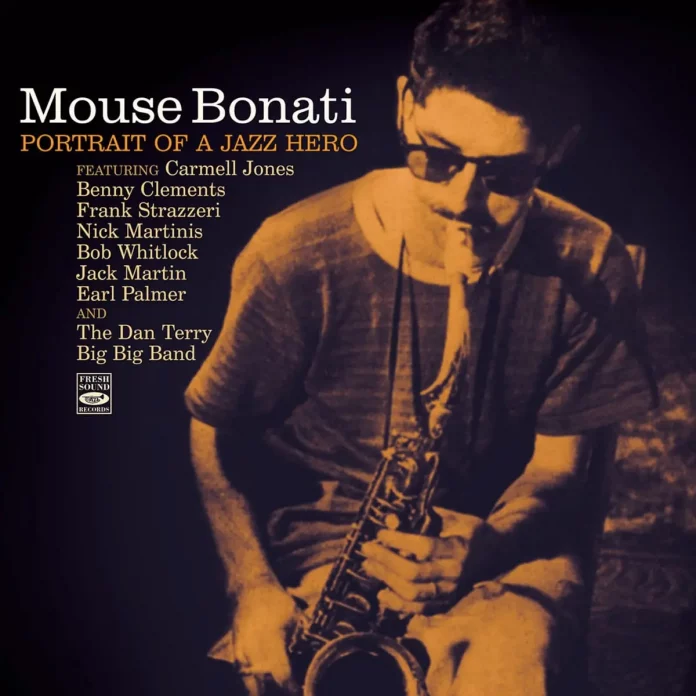The reason that Joe “Mouse” Bonati is virtually unknown is fairly obvious. A wandering alto saxophonist who for a big part of his life resided in New Orleans and on the West Coast, he was a drug addict who suffered strokes of bad luck to boot. Probation from a jail sentence prevented him from following up the invitation from Dizzy Gillespie to join his band in 1956 and he failed to build a fulfilling career. Bonati’s misfortunes are discussed in detail in the liner notes of Portrait Of A Jazz Hero, clearly a labour of love from Fresh Sound boss and busybody Jordi Pujol.
Pujol makes a case for Bonati’s exceptional bop style. It has to be said that his compilation makes abundantly clear that the reed man of Italian ancestry blew a mean horn. His nickname “Mouse” – a gift from people from his birthplace Buffalo, who saw the little kid continuously running down the streets of the ’hood – is altogether fitting on a musical level as well. Bonati devoured fast tempi, clearly inspired by the unsurpassed Charlie “Bird” Parker. While Bird flew sky-high, Mouse scurried along the baseboards and the corners of the kitchen counter, swift and unperturbed, evading a beating of the spatula with zest in the process.
Bonati’s 1962 contributions to the Frankly Jazz TV show with the quintet of pianist Frank Strazzeri (an original soloist in his own right) rank among the best of this set. Bonati takes solos with unwavering agility and drowns his hard tone in sulphuric acid. Compositions from Strazzeri such as the high-speed Injun Joe and the gospel-flavoured waltz Kid’s Delight are the perfect foil for Bonati.
The Mouse Bonati Sextet recordings, which were released on the obscure New Sounds From New Orleans LP in 1955, are equally excellent. Fiery lines mark Back, Bonati’s variation on Salt Peanuts. It’s a totally different affair compared to his work in the Dan Terry Big Big Band in 1981. By then, Bonati relied on Las Vegas orchestra pits for his income. Apparently though, his years in relative obscurity hadn’t affected his reputation: Bonati is provided with plenty of solo spots in contrast to his 18 brass and reed colleagues from the (big big) Terry band. Excepting the disco-inflected Taxi Dance, the orchestra harks back convincingly to Basie and Calloway and Bonati chimes in expertly on tenor saxophone.
Alto, though, was his first love. There is no doubt that, had he been able to get it together, Bonati would’ve been a fierce competitor to the likes of Phil Woods and Art Pepper.
Discography
Scherzo; Back; One Blind Mouse; Mouse’s House; Improvisation; What A Difference A Day Made; New Orleans; Kids Delight; Injun Joe; Lope In; Jasmine; Lover Man; Tuxedo Junction; Stompin’ At The White House; Redwood Cathedral; Cry Me A River; Taxi Dance (56.09)
Collectively: Bonati (as); Mike Mala, Benny Clements, Carmell Jones (t); Jack Martin (flh); Tommy Butcher, Chick Powers (ts); George Harris (bar); Frank Strazzeri, Ed Frank (p); Phil Darois, Jimmy Johnson, Bob Whitlock (b); Earl Palmer, Nick Martinis (d); Dan Terry (big band lead). News Orleans, Los Angeles, Las Vegas, 1955-1981. Full discography on Fresh Sound website.
Fresh Sound Records 1121
















